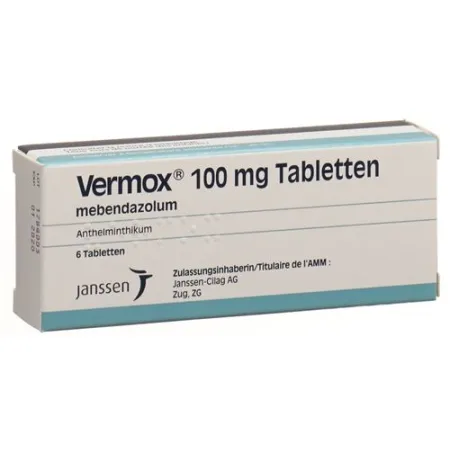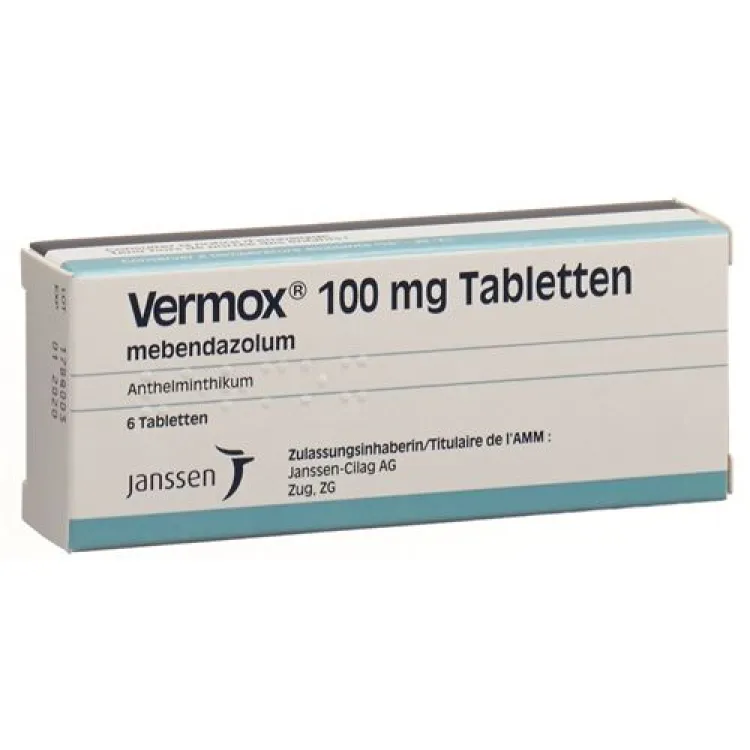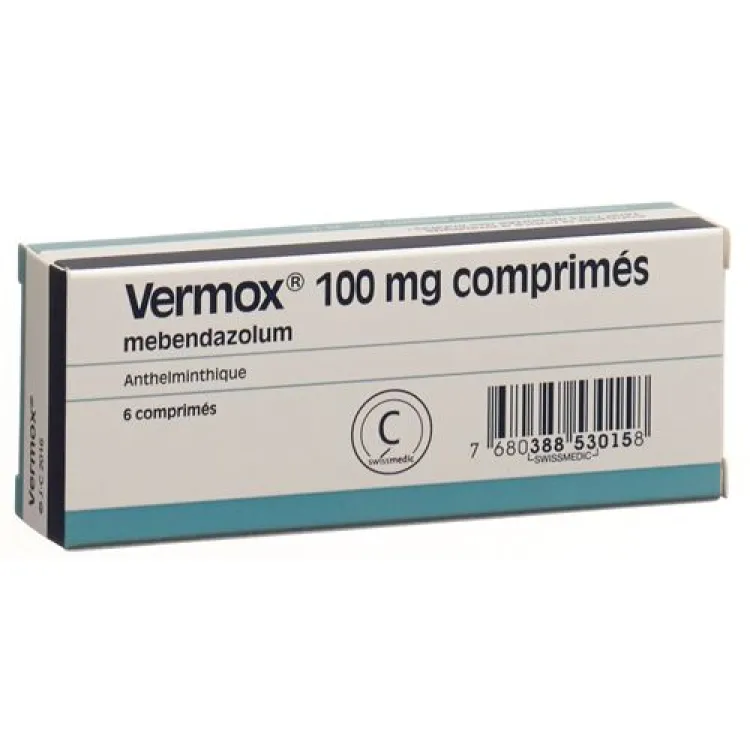Vermox 100 mg 6 tablets
Vermox Tabl 100 mg 6 Stk
-
43,60 USD

- Availability: In stock
- Distributor: JOHNSON & JOHNSON
- Brand: Vermox
- Product Code: 672627
- ATC-code P02CA01
- EAN 7680388530158
Ingredients:
Description
What is Vermox 100 mg and when is it used?
Vermox 100 mg is a medicine against worm diseases in the intestines caused by pinworms, roundworms, whipworms, palisade worms and/or hookworms.
Vermox 100 mg is also effective against certain types of tapeworm (beef and pork tapeworm).
Vermox 100 mg disrupts the metabolism of the parasites, which causes them to die and are excreted in the stool a few days later.
Since pinworms can be easily transmitted, it is entirely possible that other family members may also become ill without being detected. Under these circumstances, it is advisable to treat all members of a family or group of people.
What precautions should be taken?
Strict hygienic measures are necessary to avoid transmission of the parasites. Any direct contact of the hands with the anus should be avoided. Hands (including fingernails) must be thoroughly cleaned after each bowel movement. Underwear needs to be changed often. Vermox 100 mg does not discolor the laundry.
When should Vermox 100 mg not be taken?
If you are known to be hypersensitive to the active ingredient or one of the excipients contained in Vermox 100 mg, you must not take Vermox 100 mg.
When should you be careful when taking Vermox 100 mg?
Children under 2 years of age may only be given Vermox 100 mg if prescribed by their doctor.
Vermox 100 mg contains the azo dye yellow orange S (E110), which can cause allergic reactions. Patients who are hypersensitive to azo dyes, acetylsalicylic acid and rheumatism and painkillers (prostaglandin inhibitors) should not take Vermox 100 mg.
If you need to use a preparation containing cimetidine (a medicine for excessive stomach acid secretion), carbamazepine or phenytoin at the same time, you should tell your doctor/pharmacist/druggist about this as a precaution.
The simultaneous administration of Vermox with preparations containing metronidazole should be avoided.
This medicine contains less than 1 mmol sodium (23 mg) per tablet, meaning it is almost “sodium free”.
Tell your doctor, pharmacist or druggist if you
- suffer from other illnesses,
- Have allergies or
- Take other medicines (including those you bought yourself!)!
Can Vermox 100 mg be taken during pregnancy or while breastfeeding?
If you are pregnant, want to become pregnant or are breastfeeding, you should only take Vermox 100 mg after consulting your doctor.
In animal experiments, Vermox caused deformities in rats and mice. There is only limited experience with humans so far. Women of childbearing age should therefore only take Vermox 100 mg if pregnancy can be ruled out. If pregnancy cannot be ruled out, Vermox 100 mg must not be taken unless prescribed by your doctor.
Case reports indicate that a small amount of mebendazole is detectable in breast milk after ingestion. If you take Vermox 100 mg while breastfeeding, it is recommended to stop breastfeeding.
How do you use Vermox 100 mg?
Unless otherwise prescribed by your doctor, Vermox 100 mg is used as follows:
Vermox 100 mg tablets can be chewed or whole with some liquid or taken with food; They can also be given crushed to children.
The following dosages apply to adults and children over 1 year old, regardless of body weight:
Pinworm infestation: 1 tablet as a single dose. It is recommended to repeat the treatment after 2 weeks.
Infestation with various types of worms, roundworms, whipworms, palisade worms and hookworms: 1 tablet each morning and evening on 3 consecutive days.
Types of tapeworms: 1 - 2 tablets twice daily for 3 days.
Additional dietary measures or the use of laxatives are not necessary.
Stick to the dosage stated in the package leaflet or prescribed by your doctor. If you think the medicine is too strong or too weak, talk to your doctor, pharmacist or druggist.
What side effects can Vermox 100 mg have?
The following side effects have been identified and can occur when taking Vermox 100 mg:
Occasionally, pain and discomfort in the abdomen, diarrhea, flatulence, nausea and vomiting (these can also come from the worm infestation itself) may occur.
Rarely, a skin rash may be observed.
Severe skin diseases (Stevens-Johnsons syndrome) and hypersensitivity reactions cannot be completely ruled out; These manifest themselves as skin rashes, itching, hives and localized swelling of the face, mouth or throat (angioedema). In this case, inform your doctor immediately. He/she will decide how to continue the treatment.
In rare cases, kidney inflammation (glomerulonephritis) can also occur. Symptoms of kidney inflammation can include blood or protein in the urine.
In these cases, consult your doctor immediately if you notice signs of kidney inflammation.
In very rare cases, convulsions (especially in children and young children), dizziness and hair loss have been observed. Very rarely, changes in the blood count can also occur, which can manifest themselves as fever, sore throat and other signs of angina. Liver inflammation can also occur very rarely, which can be manifested by pain in the upper abdomen, especially under the right costal arch, loss of appetite, nausea, vomiting, fever, yellowing of the eyeballs and skin, dark discoloration of the urine and light coloring of the stool.
In these cases, consult your doctor immediately before continuing treatment.
In addition, the dye E 110 (yellow orange S) can trigger a hypersensitivity reaction on the skin and respiratory organs, especially in patients with asthma, hives (chronic urticaria) or with known hypersensitivity to acetylsalicylic acid and other rheumatism and painkillers.
Taking Vermox in higher amounts than recommended or for long periods of time can result in blood, kidney and liver diseases, which in some cases can be severe. Hair loss can also occur, which in some cases can be permanent.
If you take too much Vermox, you may suffer from stomach cramps, nausea, vomiting, diarrhea, headaches and dizziness. If this is the case, you should contact your doctor.
If you notice any side effects, contact your doctor, pharmacist or druggist. This applies in particular to side effects that are not stated in this leaflet.
What should also be noted?
Keep out of reach of children.
Vermox 100 mg should be stored in the closed original packaging in a dry place at room temperature (15 - 25 °C).
The medicine may only be used until the date marked “EXP” on the container.
After the treatment has ended, take the medicine and the remaining contents to your dispensary for proper disposal.
Your doctor, pharmacist or druggist can provide you with further information. These people have the detailed information for specialists.
What is contained in Vermox 100 mg?
Light orange round, flattened tablets containing 100 mg mebendazole per tablet.
1 tablet Vermox 100 mg contains 100 mg mebendazole as the active ingredient.
Excipients: Microcrystalline cellulose, sodium starch glycolate, talc, corn starch, magnesium stearate, hydrogenated cottonseed oil (produced from genetically modified cotton seeds), colloidal silicon oxide, sodium lauryl sulfate (E 487), aroma (orange aroma), saccharin sodium, yellow orange S (E110).
Approval number
38853 (Swissmedic)
Where can you get Vermox 100 mg? Which packs are available?
In pharmacies and drugstores, without medical prescription.
Packs of 6 tablets.
Authorization holder
Janssen-Cilag AG, Zug, ZG.





